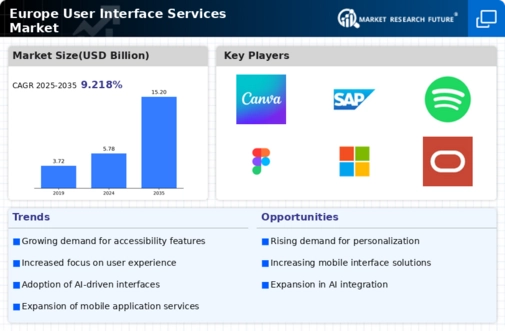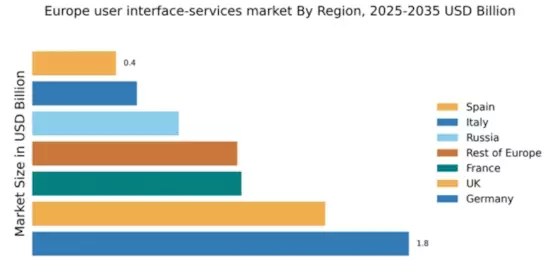The user interface-services market in Europe is characterized by a dynamic competitive landscape, driven by rapid technological advancements and evolving consumer preferences. Key players such as Adobe (US), Figma (US), and Marvel (GB) are at the forefront, each adopting distinct strategies to enhance their market positioning. Adobe (US) continues to leverage its extensive suite of creative tools, focusing on integration and user experience, while Figma (US) emphasizes collaboration and cloud-based solutions, appealing to remote teams. Marvel (GB) is carving a niche by prioritizing user-friendly design tools that cater to startups and small businesses, thus diversifying its customer base. Collectively, these strategies foster a competitive environment that encourages innovation and responsiveness to market demands.
In terms of business tactics, companies are increasingly localizing their services to better meet regional needs, optimizing supply chains to enhance efficiency. The market structure appears moderately fragmented, with a mix of established players and emerging startups. This fragmentation allows for diverse offerings, yet the influence of major companies remains substantial, shaping industry standards and customer expectations.
In October 2025, Adobe (US) announced the launch of a new AI-driven feature within its Creative Cloud suite, aimed at streamlining the design process for users. This strategic move underscores Adobe's commitment to integrating artificial intelligence into its offerings, potentially enhancing user productivity and satisfaction. The introduction of AI capabilities may also position Adobe as a leader in innovation, setting a benchmark for competitors.
In September 2025, Figma (US) expanded its partnership with major tech firms to enhance its collaborative features, allowing for seamless integration across various platforms. This initiative not only strengthens Figma's market presence but also aligns with the growing demand for tools that facilitate remote collaboration. By fostering partnerships, Figma is likely to enhance its value proposition, appealing to a broader audience.
In August 2025, Marvel (GB) launched a new subscription model aimed at small businesses, providing access to premium features at a competitive price point. This strategic decision reflects Marvel's understanding of market dynamics and the need for affordable solutions in a challenging economic environment. By catering to smaller enterprises, Marvel may increase its market share and foster brand loyalty among emerging businesses.
As of November 2025, current trends in the user interface-services market include a pronounced focus on digitalization, sustainability, and the integration of AI technologies. Strategic alliances are increasingly shaping the competitive landscape, enabling companies to pool resources and expertise. Looking ahead, it appears that competitive differentiation will evolve, with a shift from price-based competition to a focus on innovation, technological advancement, and supply chain reliability. This transition may redefine how companies engage with customers, emphasizing value creation over mere cost efficiency.


















Leave a Comment